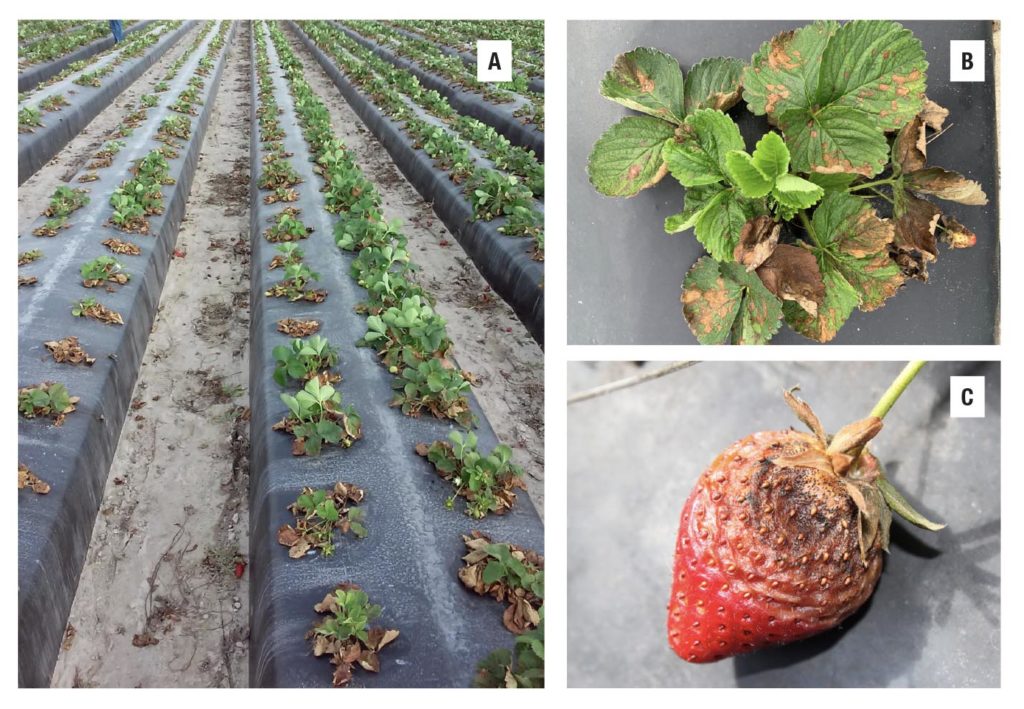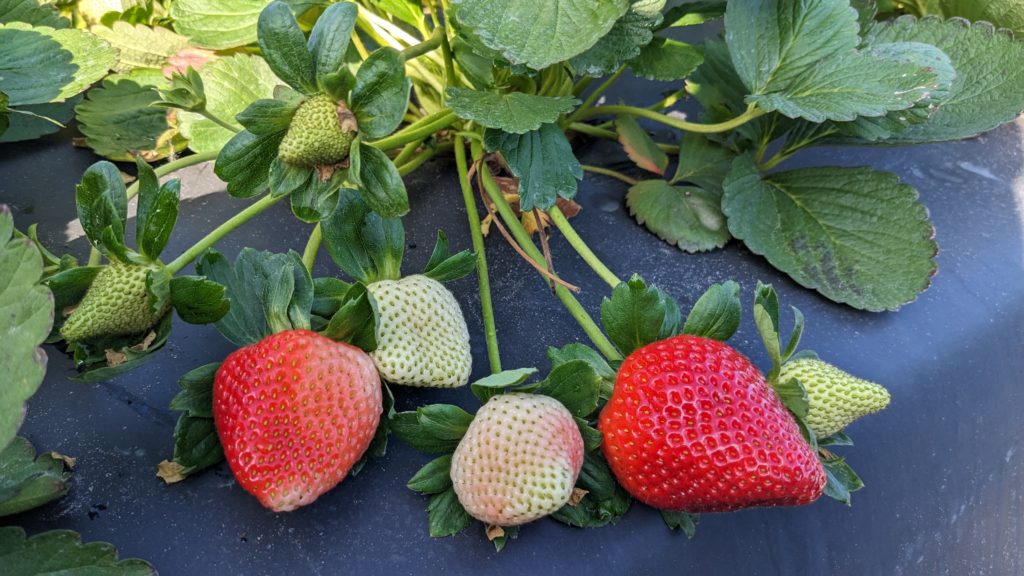By Natalia A. Peres and Vance Whitaker
As the Florida strawberry season comes to an end, it is a good time to reflect on what has been learned over the past five years about managing the emerging disease caused by the fungus Neopestalotiopsis sp. This fungus has been present for as long as strawberries have been grown but was considered a weak pathogen most commonly found on stressed plants. Thus, it was never a major concern in the industry until the 2018–19 season when major outbreaks were reported in Florida strawberry fields, and the pathogen was identified as a more aggressive species of Neopestalotiopsis. Since then, the number of commercial farms affected has significantly increased, and most Florida strawberry growers have experienced the disease at some level.
The fungus causes leaf spots and blighting of the leaves as well as fruit rot that can greatly affect yield (Figure 1). In some cases, entire fields have been rendered uneconomical to harvest and have been destroyed before the end of the season.

During the past few seasons, the severity of the disease is directly related to the environmental conditions. The fungus spreads rapidly with rain storms, and the disease is particularly favored by prolonged wetness following rain. Under optimum conditions of wetness and temperature, new symptoms are observed as soon as five days. Thus, many cycles of the disease can occur during wet seasons with multiple rain events.
The optimum temperature for disease development is 68 degrees. However, disease symptoms can be observed even at 41 degrees with 48 hours of continuous leaf wetness (water on the surface of the leaves). Fortunately, the Florida weather was favorable during this past season with no significant rain events since early January. This winter and the two previous seasons have had the influence of La Niña, which tends to be drier and thus less conducive for fungal diseases. I am sure growers appreciate the break and help from Mother Nature.
BREEDING EFFORTS
In the meantime, the University of Florida Institute of Food and Agricultural Sciences (UF/IFAS) breeding program has been working hard to select varieties with better tolerance to the disease. Researchers have learned that Florida Brilliance and Sensation® Florida127, which represent most of the acreage grown in Florida, are highly susceptible.
The newest variety, Medallion® FL 16.30-128, appears to have slightly better tolerance. The breeding program is preparing to release two new varieties that will be available to growers at scale by 2024. One of these has improved tolerance compared to the current varieties (Figure 2).

Photos by Cheryl Dalid, UF/IFAS
INOCULUM SOURCES
UF/IFAS studies have found that once introduced in a field, Neopestalotiopsis can survive in the strawberry residue materials until the following season. Fumigation of the strawberry beds early in the season does reduce the pathogen, but since the middles are not fumigated, the pathogen remains active there and serves as an initial source of inoculum.
Nevertheless, strawberry transplants still remain a major source of inoculum, and it is much more difficult to control the disease when transplants come infected from nurseries. Fields that were severely infected this season should be destroyed quickly after the end of the season, and crop residue should be incorporated into the fields as soon as possible to slow down inoculum production.
INTEGRATED APPROACH
Moving forward, disease management will rely on an integrated approach that takes into consideration the biology and epidemiology of the pathogen. The Strawberry Pathology Lab at the UF/IFAS Gulf Coast Research and Education Center (GCREC) has been working hard on several trials to develop that knowledge quickly.
The main question from growers is about which fungicides to use. UF/IFAS field experiments during the past few seasons have shown that options are few and limited. Among currently registered products, programs that include Switch 62.5WG and Thiram SC have been the most effective. Some demethylation inhibitor fungicides such as Rhyme, Tilt and Inspire also have some activity and can be used in the rotation. Treatments including these fungicides usually increased yield over the non-treated control, but over 30% fruit rot can still be observed even in the best treatments (compared to 80% in the non-treated control).
Unfortunately, the industry already relies greatly on Switch for control of botrytis fruit rot, and the overuse of this product can lead to increased selection for fungicide resistance. Thus, applications need to be limited to periods when weather conditions are favorable and following the maximum number allowed by the label, while researchers continue to seek alternatives.
Additional sanitation practices such as cleaning and disinfestation of equipment with quaternary ammonium products, limiting field operations such as harvesting and spraying when plants are wet, and sanitation of employees’ hands, shoes and clothes also help to minimize the spread of Neopestalotiopsis within and between fields during the season.
This new disease has added yet another challenge to the industry, but UF/IFAS strawberry researchers at GCREC are working to develop integrated disease management recommendations as well as easier and quicker means to identify the disease, which is easily confused with many other leaf spots affecting strawberry. Since there are many other species of Neopestalotiopsis that are not as aggressive, the UF/IFAS team has developed a DNA test for rapid diagnosis. The team also is currently collaborating on a project using artificial intelligence for rapid identification of the symptoms. A smartphone app prototype should be available for growers to test by next season.
Natalia A. Peres and Vance Whitaker are professors at the UF/IFAS GCREC in Wimauma.









